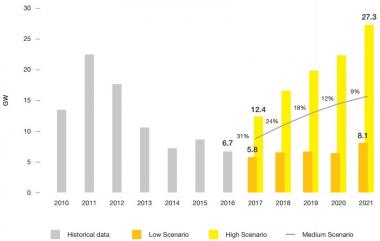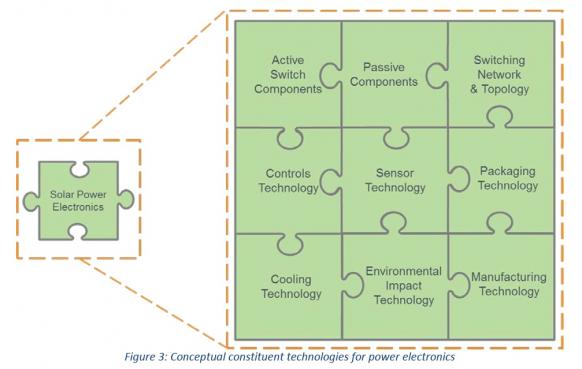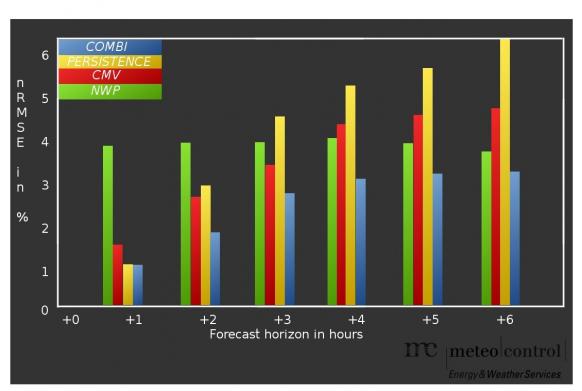Europe's grid services reforms set to boost solar economics
Reforms to ancillary market contracts should help solar operators position themselves in grid balancing markets and capitalize on technology gains, industry experts told New Energy Update.

Related Articles
As solar power operators plan for the removal of renewable energy subsidies, technology improvements are set to provide more revenue opportunities from grid services. Grid operators are developing new market designs to accommodate rising renewable energy capacity, storage and demand management technology.
Utility-scale plants are already capable of providing reactive power, voltage support and frequency support. However, many of Europe's markets require ancillary market reforms so that incentives reward solar plant capabilities. Market rules on lead times and imbalance penalties have presented a barrier to many PV operators.
European Union (EU) market reforms currently underway are set to provide a wider role for renewables, Sonia Dunlop, Policy Adviser at SolarPower Europe, said.
“A lot of what’s happening in terms of market design at EU level is about making the ancillary services market more friendly to renewables,” she said.
Proposed reforms include allowing balancing participants to offer either upwards or downwards bidding, Dunlop said. Operators are currently often required to bid for both upward and downward adjustments.
Timeframes for bids can vary between market. Shorter time frames to accommodate renewable energy intermittency would further support entry into many ancillary services markets, Dunlop said.
Following negotiations between EU member states, the new market regulation is expected to be implemented by 2020, although the roll out of certain measures may be staggered by several years.
Forecast annual solar installations in Europe
(Click image to enlarge)
Source: SolarPower Europe's "Global Market Outlook 2017 to 2021."
US progress
As U.S. wind and solar capacity surges, a number of regional grid operators are testing new market designs which allow solar operators to participate in balancing, voltage and frequency response markets.
Proactive measures by system operators in New York and California, among others, come amid increasing federal pressure to improve grid reliability. The Federal Energy Regulatory Commission (FERC) is planning to implement frequency response requirements and the Department of Energy (DOE) has recommended the use of pricing mechanisms which value Essential Reliability Services (ERS) and Bulk Power System resilience (BSR).
Last year a joint project by First Solar, California ISO CAISO and the National Renewable Energy Laboratory (NREL), demonstrated large-scale utility solar plants can provide many of these grid services.
The partners used a 300 MW plant to provide spinning reserve, load following, voltage support, ramping and frequency regulation capability.
The project won an innovation award from the National Association of Regulatory Utility Commissioners (NARUC). The commissioners noted First Solar’s plant responded to dispatch far more accurately than conventional generation such as thermal or hydroelectric plants.
"The automatic generation control (AGC) test showed regulation accuracy of 87 to 93% compared to the best accuracy of convention generation of 63%," NARUC said.
In September 2017, the US Department of Energy's (DoE) Solar Energy office launched a new round of R&D funding for solar electronics innovations in a bid to improve grid reliability, resilience, and storage.
UK reforms
In Europe, the UK is moving forward with new grid designs which are set to impact the economics of energy storage.
The UK's National Grid has already issued tenders for fast frequency response services from energy storage applications and the operator is currently consolidating and simplifying numerous ancillary services contract tenders, following a 2017 review on grid balancing requirements. Going forward, there will be fewer types of ancillary contracts and they will be more standardized. Further announcements on the reforms are expected this spring.
One key issue for the PV plant owners will be the duration of the contract terms, typically deemed too short for many market players, Jean-Pascal Boutin, a partner at law firm Eversheds Sutherland, said.
The reforms could impact the development of solar plus storage plants and risks remain over how the National Grid will proceed, Boutin said.
“The ancillary services market can be quite challenging and the pure balance sheet and market play is limited, so to get these batteries installed requires a strong price signal from National Grid in the UK or their equivalent [in other countries] to back the capital investment,” he said.
Other behind-the-meter business models will also become available, Boutin said.
“Moving forward not only will there be ancillary service contracts available through the National Grid but there will also be similar contracts available to Distribution Network Operators (DNO),” he said.
Plant control
Advances in PV plant control are expected to open up new revenue streams. The power electronics interfaces of PV plants make them well-equipped to provide fast communications services to aid grid balancing.
It is already possible for solar inverters to provide grid services at night by taking active power from the grid, applying a phase shift and feeding it back in to the grid as reactive power.
The U.S. Department of Energy is currently funding the development of new inverter designs which increase the efficiency, reliability and flexibility of solar plants.
Enhancements in the operational functionality of inverters could integrate new communication capabilities, Charlie Gay, Director of the Department of Energy's Solar Energy Technologies Office, told New Energy Update in September.
"This communications capability could be used to offer a grid operator control of voltage and frequency parameters. That information might also feed back to a power plant operator who can see in real time the status and performance of each of the inverters," he said.
Constituent technologies for power electronics
(Click image to enlarge)
Source: DoE's Funding Opportunity Announcement: "Advanced power electronics designs for solar applications." (2017)
As the market penetration of solar power increases, local operators facing grid congestion will be expected to secure more control over PV systems for ramping flexibility, Dunlop said.
“Inverters can be controlled to micro-second levels and that’s really important in terms of providing accurate grid services,” she said.
Data markets
Advances in data reporting and sharing will be key to ensuring efficient ancillary services in power markets. More accurate solar forecasting data is helping operators increase revenues and minimize the balancing costs for the plant operator and the TSO.
Innovations in computer-modelled weather forecasting, satellite technology, self-learning and image processing, combined with big data analytics, is improving the accuracy of solar forecasting, SolarPower Europe said in a recent report on digitalization.
"Forecasts can be delivered from the next minute up to several days on areas spanning from a couple to tens of kilometres," it said.
Forecasting companies are supplying increasingly-sophisticated data sources, allowing plant by plant analysis, Dunlop said.
"Almost every TSO in Europe now contracts with one of these companies to get as accurate as possible forecasts," she said.
Error rates of intra-day forecasting techniques
(Click image to enlarge)
NRMSE = normalized root mean squared error (a measure of deviation between predicted and actual results, widely used by the solar industry).
Combi = combination of forecast techniques
Persistence = forecast based on current solar conditions
CMV = cloud motion vector
NWP = numerical weather prediction
Source: Meteocontrol
In September, the UKs’ National Grid announced it would share energy system and weather forecast data to support more effective grid management.
“We're providing our forecast data in a format that allows technology companies to build innovative apps and software that could make a real difference to how and when people use energy," Duncan Burt, Director of Operations at National Grid, said in a statement.
Data exchanges create additional revenue opportunities for PV operators and suppliers.
In one example, German TSO Tennet is buying real-time generation data from inverter manufacturer SMA Solar to improve its analysis.
Tennet uses the data to prepare region-specific solar power predictions to better integrate renewable energy supplies and reduce grid bottlenecks.
“These measures not only increase system safety but, due to the grid charges, they also ultimately have a positive impact on electricity prices,” the TSO said in a statement.
By David Appleyard



